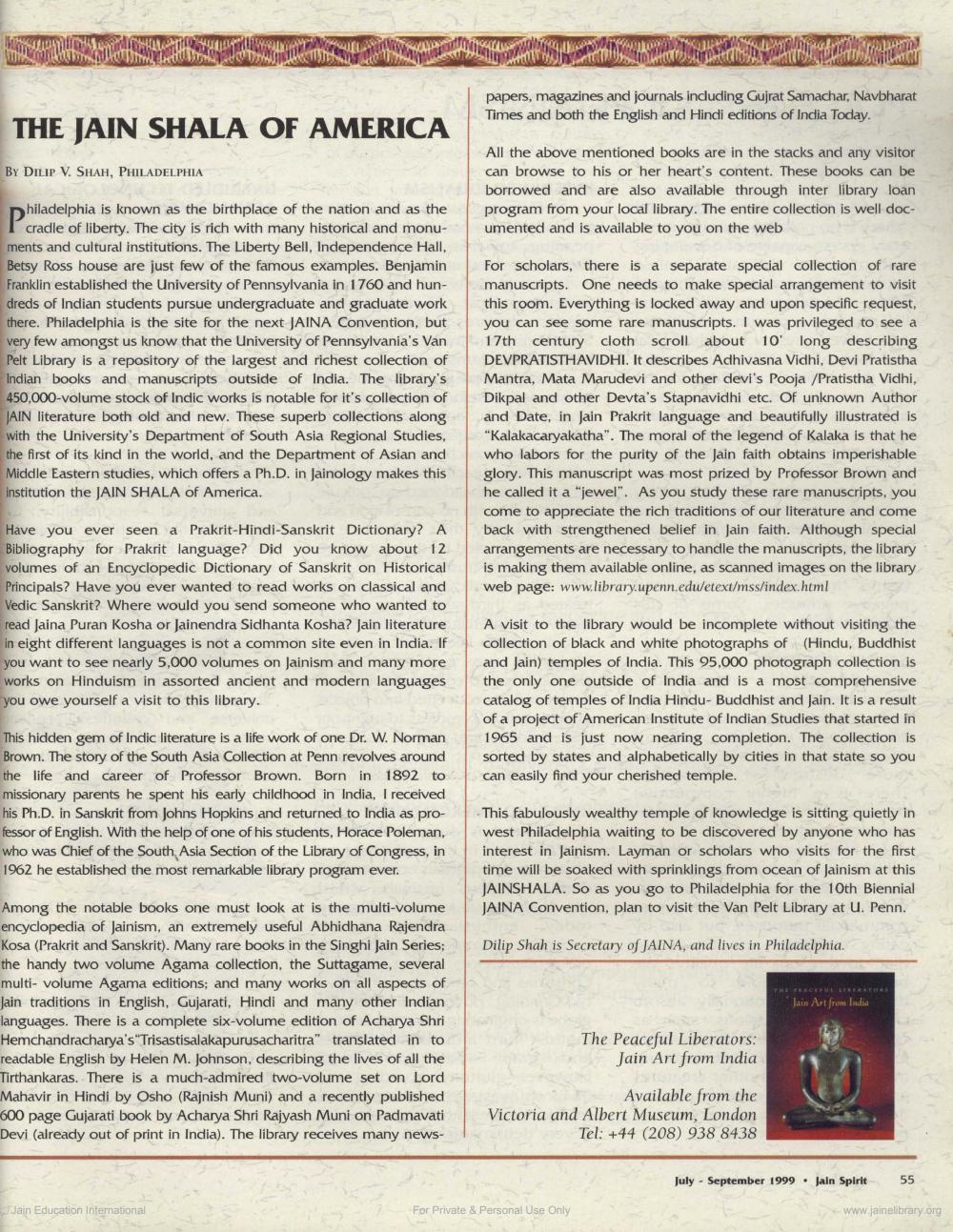________________
THE JAIN SHALA OF AMERICA
BY DILIP V. SHAH, PHILADELPHIA
hiladelphia is known as the birthplace of the nation and as the
of liberty. The city is with many historical and monu
ments and cultural institutions. The Liberty Bell, Independence Hall, Betsy Ross house are just few of the famous examples. Benjamin Franklin established the University of Pennsylvania in 1760 and hundreds of Indian students pursue undergraduate and graduate work there. Philadelphia is the site for the next JAINA Convention, but very few amongst us know that the University of Pennsylvania's Van Pelt Library is a repository of the largest and richest collection of Indian books and manuscripts outside of India. The library's 450,000-volume stock of Indic works is notable for it's collection of JAIN literature both old and new. These superb collections along with the University's Department of South Asia Regional Studies, the first of its kind in the world, and the Department of Asian and Middle Eastern studies, which offers a Ph.D. in Jainology makes this institution the JAIN SHALA of America.
Have you ever seen a Prakrit-Hindi-Sanskrit Dictionary? A Bibliography for Prakrit language? Did you know about 12 volumes of an Encyclopedic Dictionary of Sanskrit on Historical Principals? Have you ever wanted to read works on classical and Vedic Sanskrit? Where would you send someone who wanted to read Jaina Puran Kosha or Jainendra Sidhanta Kosha? Jain literature in eight different languages is not a common site even in India. If you want to see nearly 5,000 volumes on Jainism and many more works on Hinduism in assorted ancient and modern languages you owe yourself a visit to this library.
This hidden gem of Indic literature is a life work of one Dr. W. Norman Brown. The story of the South Asia Collection at Penn revolves around the life and career of Professor Brown. Born in 1892 to missionary parents he spent his early childhood in India, I received his Ph.D. in Sanskrit from Johns Hopkins and returned to India as professor of English. With the help of one of his students, Horace Poleman, who was Chief of the South Asia Section of the Library of Congress, in 1962 he established the most remarkable library program ever.
Among the notable books one must look at is the multi-volume encyclopedia of Jainism, an extremely useful Abhidhana Rajendra Kosa (Prakrit and Sanskrit). Many rare books in the Singhi Jain Series; the handy two volume Agama collection, the Suttagame, several multi-volume Agama editions; and many works on all aspects of Jain traditions in English, Gujarati, Hindi and many other Indian languages. There is a complete six-volume edition of Acharya Shri Hemchandracharya's "Trisastisalakapurusacharitra" translated in to readable English by Helen M. Johnson, describing the lives of all the Tirthankaras. There is a much-admired two-volume set on Lord Mahavir in Hindi by Osho (Rajnish Muni) and a recently published 600 page Gujarati book by Acharya Shri Rajyash Muni on Padmavati Devi (already out of print in India). The library receives many news
Jain Education International
papers, magazines and journals including Gujrat Samachar, Navbharat Times and both the English and Hindi editions of India Today.
All the above mentioned books are in the stacks and any visitor can browse to his or her heart's content. These books can be borrowed and are also available through inter library loan program from your local library. The entire collection is well documented and is available to you on the web
For scholars, there is a separate special collection of rare manuscripts. One needs to make special arrangement to visit this room. Everything is locked away and upon specific request, you can see some rare manuscripts. I was privileged to see a 17th century cloth scroll about 10' long describing DEVPRATISTHAVIDHI. It describes Adhivasna Vidhi, Devi Pratistha Mantra, Mata Marudevi and other devi's Pooja /Pratistha Vidhi, Dikpal and other Devta's Stapnavidhi etc. Of unknown Author and Date, in Jain Prakrit language and beautifully illustrated is "Kalakacaryakatha". The moral of the legend of Kalaka is that he who labors for the purity of the Jain faith obtains imperishable glory. This manuscript was most prized by Professor Brown and he called it a "jewel". As you study these rare manuscripts, you come to appreciate the rich traditions of our literature and come back with strengthened belief in Jain faith. Although special arrangements are necessary to handle the manuscripts, the library is making them available online, as scanned images on the library web page: www.library.upenn.edu/etext/mss/index.html
A visit to the library would be incomplete without visiting the collection of black and white photographs of (Hindu, Buddhist and Jain) temples of India. This 95,000 photograph collection is the only one outside of India and is a most comprehensive catalog of temples of India Hindu- Buddhist and Jain. It is a result of a project of American Institute of Indian Studies that started in 1965 and is just now nearing completion. The collection is sorted by states and alphabetically by cities in that state so you can easily find your cherished temple.
This fabulously wealthy temple of knowledge is sitting quietly in west Philadelphia waiting to be discovered by anyone who has interest in Jainism. Layman or scholars who visits for the first time will be soaked with sprinklings from ocean of Jainism at this JAINSHALA. So as you go to Philadelphia for the 10th Biennial JAINA Convention, plan to visit the Van Pelt Library at U. Penn.
Dilip Shah is Secretary of JAINA, and lives in Philadelphia.
The Peaceful Liberators: Jain Art from India
Available from the Victoria and Albert Museum, London Tel: +44 (208) 938 8438
For Private & Personal Use Only
THE PEACEFUL LIRERACoe
Jain Art from India
July-September 1999. Jain Spirit
55
www.jainelibrary.org




